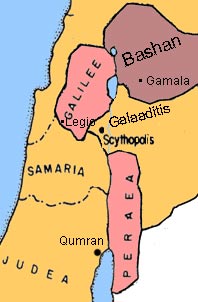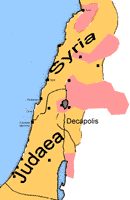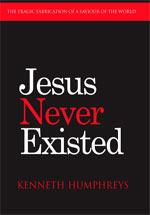Messiahs R'Us:
"A Galilean Rebel – Judas"
In the year 6 AD a Judas of Gamala, otherwise known as the Galilean, and a Pharisee called Zadok, denounced Roman taxation as slavery and began a widespread insurrection.
Judas, it seems, was the author of the "fourth branch of Jewish philosophy", Pharisaic in all essentials and recognizing only God as Lord.
"They also do not value dying any kinds of death, nor indeed do they heed the deaths of their relations and friends, nor can any such fear make them call any man lord."
– Josephus, Antiquities 18
In 47 AD James and Simon, sons of Judas, and now running the family business of rebellion, were caught by the prefect Tiberius Alexander (an apostate Jew) and crucified.
In the mid-years of the 1st century AD Nazarene rebels operated west of the Jordan, John the Baptist worked the Dead Sea Coast of Peraea, a Moses reappeared in Samaria, and an 'army' of Theudas the Egyptian massed on the Mount of Olives by Jerusalem.
The Romans were having none of it.
Messiahs R'Us:
"Moses Reborn"
In contrast to the peaceful activities of John the Baptist, about the same time a rebel claiming to be a reincarnated Moses, raised an armed following in Samaria.
The revolt was brutally suppressed by the Romans.
Samaritan complaints of excessive violence led the Syrian Governor to retire the long-serving prefect of Judaea – Pontius Pilate.
Perhaps inspired by the Samaritan, some ten years later "a certain magician, Theudas" deluded a multitude of followers that he would "divide the River Jordan." The prefect Fadus cut off his head.
"Prophet on the Mount of Olives"
"There was an Egyptian false prophet ... got together thirty thousand men that were deluded by him; these he led round about from the wilderness to the mount which was called the Mount of Olives.
Felix ... met him with his Roman soldiers ... the multitude were dispersed ... and concealed themselves."
Josephus – War 2.
In 66 AD Menahem, the (grand?) son of Judas the Galilean, took an active role in the war against Rome. His group captured the governor's palace in Jerusalem and executed the high priest Ananias.
His triumph was short-lived: he was captured by his Jewish opponents and tortured to death.
.
Up There!
"Thanks to the 'evangelisation' carried out by the earliest apostles, Paul and his contemporaries, the communities were made to realise that the great teacher and prophet whom they took to be the founder of their Church, and who they believed had been dead for over a hundred years, had now been seen in Heaven, and should be regarded as the Messiah, their Saviour ...
But after the apostles had been overwhelmed by the experience of seeing him in Heaven, they began to use ... the name Jesus, a name meaning, roughly, Salvation, and therefore very appropriate for somebody they had now come to look upon primarily as their Saviour."
– Alvar Ellegård, Jesus, One Hundred Years Before Christ, p. 120
The Eve of War
In the 60s AD Herod Agrippa II held dispersed territories included Abilene and Chalcis in Syria.
His heartland, Galilee and Trachonitis, were separated from Judaea by the region of semi-autonomous Greek cities of the Decapolis.
Agrippa, as a client king of Rome, raised armies to fight alongside the legions.
Judgement Day
Qumran – Essene, or perhaps Zealot, training camp for the war of Light and Darkness.
In the summer of 68, X Legion Fretensis was active in the valley of the river Jordan and destroyed the 'monastery' of Qumran.
After the capture of Gamala, the X moved to a base at Scythopolis.
The Essene leadership, however, had been in Jerusalem and would probably have perished in the siege of 70 AD.
|
||||
Jewish Gnosis: Paul's "good news" for the Essenes –
 |
|
The pacifist response to Roman occupation took more than one form.
The Romanisation of Palestine not only radicalised those Jews who resisted colonisation: it Hellenized the collaborators who embraced the new reality. An early Jewish Gnostic was the Samaritan "Simon the Magus" whose legacy was to inspire both the mystical "Kabala" (a refinement of Pythagorean "magic" numbers) and later Christian Gnostics – Basilides, Saturninus, Carpocrates among them.
Probably the
most successful student of Simon was the apostle Paul, who would
concoct a new, Jewish-oriented version of the ancient mystery cult
tradition of dying and rising gods. In common with all the early
Christian writers, Paul knew nothing of any human Jesus. His saviour
originated (and remained!) in the ethereal world of pious imagination,
both crucified by and triumphing over "Principalities
and Powers":
"We speak the Wisdom of God in a mystery ... Which none of the Princes of this World knew: for had they known it, they would not have crucified the Lord of Glory."
– 1 Corinthians 2:7,8"And having spoiled Principalities and Powers, He made a shew of them openly, triumphing over them in it."
– Colossians 2.15
Paul justifies
all this by recourse to Jewish scripture – not
any appeal to an historic reality. Thus, "Christ died for
our sins according to the scriptures" and "he
was buried, and that he rose again the third day according
to the scriptures" (Corinthians 15.3,4)
Paul's target audiences are the synagogues established in the diaspora – Corinth, Philippi, Ephesus, Colossi, (the same "churches" berated in Revelation) – where he confronts rival salesmen (Apollos, followers of John, etc.) but has a "good news" message for the Essenes, whose memories of their founder are growing dim with time.
Paul
has had
a vision. He has seen the anointed one and he now sits at God's
right hand! His
death
was a redemption (just like that of Adonis, Osiris, Dionysus,
et al!) and his followers can look forward to salvation
and an eternal life.
Paul finds The Exalted One a name… "Jesus"
It would be reasonable to suppose that in identifying their dead hero with those of the past the Essenes had accorded him the same hallowed name: Joshua/Jesus. Unfortunately, use by the Essenes of cryptic pseudonyms denies us that confirmation.
However, quoted by Paul in his Epistle to the Philippians is a hymn, perhaps one which originated with the Essenes, whose synagogues in the Diaspora were the apostle's chosen recruiting ground. Paul is hoping to win converts with his Gnosticised Judaism.
Paul is endeavouring to strengthen the faith of the brethren and in the hymn a heavenly being has "emptied himself" by taking the form of a servant of the Lord. The humiliating self-sacrifice earns the god a name "above all others":
”Therefore God has highly exalted him,
And bestowed on him the name that is above every name,
That at the name of Jesus, every knee should bow,
In heaven and on earth, and under the earth,
And every tongue confess that Jesus Christ is Lord
To the glory of God the Father." – Philippians 2.9,11.
How did a dead Essene make it to heaven? This neat trick (by now the Zadokite founder of the Essenes had been dead for 150 years) was achieved by "raising him", like Elijah, to heaven. God, it seems, had "glorified his servant", had "exalted" him to his right hand, he had entered or been "assumed" into Heaven. And Paul could agree with the Essenes: in the imminent Last of Days the sinful world would be destroyed utterly and the "brotherhood of the righteous" would inherit the earth.
The War of Light
and Darkness
"And when ye shall see Jerusalem compassed with armies, then know that the desolation thereof is nigh.
Then let them which are in Judaea flee to the mountains; and let them which are in the midst of it depart out; and let not them that are in the countries enter thereinto ... But woe unto them that are with child, and to them that give suck, in those days! for there shall be great distress in the land, and wrath upon this people.
And they shall fall by the edge of the sword, and shall be led away captive into all nations: and Jerusalem shall be trodden down of the Gentiles."
– Luke (21.20,24), doubtless drawing on Josephus's description of the siege and famine in Jerusalem.
Paul himself passed on to heaven – or maybe just died – shortly before the violent eruption of the Jewish civil war and war against Rome.
The Jewish aristocracy was fatally split on the confrontation with Rome. Those whose ambition exceeded their judgement tried unsuccessfully to put themselves at the head of the popular movement and limit radical attacks upon all men of property. Indeed, discord was everywhere: Pharisee against Sadducee, Samaritan against Judaean, Syrian against Jew.
As the Roman war machine slowly yet relentlessly pacified the areas of rebellion, Zealots, Sicarii, Essenes and insurgents of all shades fled to the diminishing enclave around Jerusalem with the consequence that the aristocrats lost control and the 'revolution' became radicalised.
The radical factions were themselves in conflict. When the Idumean Simon bar Giora entered Jerusalem he came as "King of the Jews" yet John of Gischala continued to control most of the city. Resisting both were fanatical Zealots, who turned the Temple itself into a citadel and anticipated divine deliverance at the final hour.
Factional strife ceased only when Titus's four legions besieged the city for five months in 70 AD but by then the situation had become hopeless. Eventually breaching the formidable walls of the city, the Romans overwhelmed the hungry defenders. The Temple itself was burned to the ground and the city gutted. A few hundred Sicarii/Essene extremists continued resistance further south, in the fortress palace of Massada. But after a three year siege they, too, were defeated. Their mass suicide is renowned.
Location, Location
If we can believe Eusebius among others (Ecc. His. 3.5.3), the proto-Christians made a smart exit before the disaster and made straight for Pella, a thoroughly Greek city of the Decapolis.
Perhaps while the militants were going up in flames, the proto-Christians first pondered the possibility of a pacifist hero who would not bring the Romans down on top of them?
 |
|
However – Yet another void
"The first settlers at ancient Pella arrived in the Neolithic period, around 7500 B.C., and the site’s occupation continued for thousands of years.
When it came to first-century A.D. settlement at Pella, Jordan, archaeology surprisingly produced practically no remains. It seems that no one was living there at the time.
Soon after, the Romans resettled ancient Pella in the second century and developed it into a thriving economic center."
– Biblical Archaeology Review, May/June 2013
A Dying Flame – The Rebellion of 114-117
Last Breath – The War of 130-135
Sources:
Israel Shahak, Jewish History, Jewish Religion,The Weight of Three
Thousand Years (Pluto, 1997)
Michael Grant, Herod the Great (McGraw-Hill, 1971)
Neil Faulkner, Apocalypse-The Great Jewish Revolt Against Rome AD66-73 (Tempus,
2004)
Tacitus, The Annals of Imperial Rome (Guild, 1990)
Nigel Rogers, The History & Conquests of Ancient Rome (Access, 2004)
|
||||||||||||||||||||||||||||||||||||||||||
'Save' a friend e-mail this page
Copyright © 2005
by Kenneth Humphreys.
|






